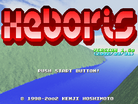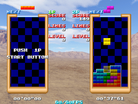Heboris: Difference between revisions
| Line 65: | Line 65: | ||
|- | |- | ||
|26||40||28||15 | |26||40||28||15 | ||
|} | |||
{| class="wikitable" | |||
|+ Gravity (v1.50) | |||
! Level !! Gravity (1/60 G) !! Level !! Gravity (1/60 G) | |||
|- | |||
|0||1||17||12 | |||
|- | |||
|1||2||18||15 | |||
|- | |||
|2||3||19||20 | |||
|- | |||
|3||4||20||30 | |||
|- | |||
|4||5||21||30 | |||
|- | |||
|5||6||22||2 | |||
|- | |||
|6||8||23||6 | |||
|- | |||
|7||10||24||10 | |||
|- | |||
|8||12||25||15 | |||
|- | |||
|9||15||26||20 | |||
|- | |||
|10||20||27||30 | |||
|- | |||
|11||20||28||45 | |||
|- | |||
|12||0||29||60 | |||
|- | |||
|13||2||60||120 | |||
|- | |||
|14||4||75||240 | |||
|- | |||
|15||6||90||300 | |||
|- | |||
|16||10||99||1200 | |||
|} | |} | ||
Latest revision as of 22:49, 23 November 2024
| Heboris | |
|---|---|
| Developer(s) | Kenji Hosimoto |
| Publisher(s) | Kenji Hosimoto |
| Platform(s) | Microsoft Windows |
| Release | 2001 (First release) |
| Latest release | 1.60 (2002-03-31) |
| Gameplay info | |
| Next pieces | 1 |
| Playfield size | 10w x 21h (20h visible) |
| Hold piece | None |
| Hard drop | Yes |
| Rotation system | TGM style wallkick |
Heboris is a game developed in 2001 by Kenji Hosimoto, aka Hosiken. Many, but not all, of its behaviors bear a resemblance to Tetris The Absolute The Grand Master 2, the latest TGM series game at that point. The game was developed using YaneuraoGameScript 2000 (YGS2K), which is a scripting language and runtime environment created by Urao Yane.
Modes
Solo
Beginner
This is an easy mode with a slow gravity curve.
| Level | Gravity (1/60 G) | Level | Gravity (1/60 G) |
|---|---|---|---|
| 0 | 2 | 17 | 15 |
| 1 | 3 | 18 | 20 |
| 2 | 4 | 19 | 30 |
| 3 | 5 | 20 | 2 |
| 4 | 6 | 21 | 4 |
| 5 | 8 | 22 | 6 |
| 6 | 10 | 23 | 10 |
| 7 | 12 | 24 | 15 |
| 8 | 15 | 25 | 20 |
| 9 | 20 | 26 | 30 |
| 10 | 20 | 27 | 45 |
| 11 | 1 | 28 | 60 |
| 12 | 2 | 60 | 120 |
| 13 | 4 | 75 | 240 |
| 14 | 6 | 90 | 300 |
| 15 | 10 | 99 | 1200 |
| 16 | 12 |
| Entry | Line clear | Lock | DAS |
|---|---|---|---|
| 26 | 40 | 28 | 15 |
| Level | Gravity (1/60 G) | Level | Gravity (1/60 G) |
|---|---|---|---|
| 0 | 1 | 17 | 12 |
| 1 | 2 | 18 | 15 |
| 2 | 3 | 19 | 20 |
| 3 | 4 | 20 | 30 |
| 4 | 5 | 21 | 30 |
| 5 | 6 | 22 | 2 |
| 6 | 8 | 23 | 6 |
| 7 | 10 | 24 | 10 |
| 8 | 12 | 25 | 15 |
| 9 | 15 | 26 | 20 |
| 10 | 20 | 27 | 30 |
| 11 | 20 | 28 | 45 |
| 12 | 0 | 29 | 60 |
| 13 | 2 | 60 | 120 |
| 14 | 4 | 75 | 240 |
| 15 | 6 | 90 | 300 |
| 16 | 10 | 99 | 1200 |
Master
This is a harder mode with a speed curve reminiscent of TGM.
| Level | Gravity (1/60 G) | Level | Gravity (1/60 G) |
|---|---|---|---|
| 0 | 2 | 15 | 60 |
| 1 | 3 | 16 | 60 |
| 2 | 5 | 17 | 60 |
| 3 | 6 | 18 | 60 |
| 4 | 8 | 19 | 60 |
| 5 | 10 | 20 | 120 |
| 6 | 12 | 21 | 120 |
| 7 | 15 | 22 | 180 |
| 8 | 20 | 23 | 180 |
| 9 | 30 | 24 | 240 |
| 10 | 30 | 25 | 300 |
| 11 | 1 | 26 | 300 |
| 12 | 5 | 27 | 240 |
| 13 | 12 | 28 | 180 |
| 14 | 30 | 29 | 1200 |
The following delays are unadjusted values direct from the source code.
| Level | Entry | Line clear | Lock | DAS |
|---|---|---|---|---|
| 0 | 26 | 40 | 28 | 15 |
| 30 | 27 | 25 | 28 | 9 |
| 33 | 27 | 22 | 28 | 9 |
| 36 | 27 | 18 | 28 | 9 |
| 39 | 27 | 15 | 28 | 9 |
| 42 | 18 | 12 | 28 | 8 |
| 45 | 18 | 10 | 28 | 8 |
| 48 | 16 | 8 | 28 | 8 |
| 51 | 15 | 6 | 28 | 8 |
| 54 | 14 | 5 | 28 | 7 |
| 57 | 14 | 4 | 22 | 7 |
| 60 | 13 | 3 | 15 | 7 |
20G
This is similar to Master but begins at 20G.
Delays are the same as Master except that DAS begins at 12 frames.
Devil
This is a high-difficulty 20G mode.
| Level | Entry | Line clear | Lock | DAS |
|---|---|---|---|---|
| 0 | 18 | 13 | 28 | 10 |
| 3 | 16 | 11 | 26 | 10 |
| 6 | 14 | 10 | 25 | 10 |
| 9 | 12 | 9 | 23 | 9 |
| 12 | 10 | 8 | 20 | 9 |
| 15 | 9 | 7 | 16 | 9 |
| 18 | 8 | 7 | 15 | 9 |
| 21 | 8 | 6 | 14 | 8 |
| 24 | 7 | 6 | 13 | 7 |
| 27 | 6 | 5 | 13 | 7 |
| 30 | 5 | 5 | 13 | 7 |
Versus
Gameplay
While the game engine is largely similar to TGM, one notable change is that DAS happens after a piece spawns but before gravity is applied. This effectively gives additional placement options in 20G, making the game significantly easier since fundoshi situations are no longer threatening.
Level progression
Levels are based on internal level progression. Levels progression increases by 1 unit per piece and 20 units per line, and a level up takes place every 100 units.
Scoring
Scoring is similar to Tetris (Sega), but with combo bonuses.
- Line Clear Score = Scoring Rate × Line Multiplier × Gravity Multiplier
Scoring rate is 100 if no combo is present. A line clear that continues a combo will increase the scoring rate (this takes effect after the clear).
| Event | Line multiplier | Scoring rate increase |
|---|---|---|
| Single | 1 | +5 |
| Double | 4 | +10 |
| Triple | 9 | +30 |
| Heboris | 20 | +50 |
| Gravity (G) | Multiplier |
|---|---|
| 0 - <1/3 | 1 |
| 1/3 - <1 | 2 |
| 1 - 3 | 3 |
| 4 | 4 |
| 20 | 5 |
Unofficial Expansion
Main Articles:
Heboris Unofficial Expansion
Heboris U.E. LITE
Heboris U.E. MINI
In 2002, development of the game has been in stasis. Because of YGS2K being a script language and the source code cannot be made inaccessible, it was a target of being modified by anonymous third parties mainly in the 2ch community. It received modifications, such as new rotation systems and game modes, which later became part of its unofficial expansion.
C++ Port
As the unofficial expansion development continued, it became evident that the developers were hitting the limits of YGS2K's specifications. This was one reason the LITE version was developed, but it itself was to bear the same burden as the original modification, as it was still based on the still environment. In September 2006, an individual in the 2ch forums successfully ported Heboris and Heboris U.E. into a C++ and DirectX 9-based environment, by going through the code and re-implementing the YGS2K specific calls using DirectX. A version using the SDL library also followed shortly, and the SDL version was successfully ported over to macOS as well.
However, development of the C++ versions have stagnated since then. Contributors to the project still wrote code in YGS2K without migrating to C++, possibly due to the steeper learning curve and the hassle to set up a development environment in C++. The latest version of Heboris U.E. continues to be developed and provided in YGS2K.
See also
External links
- Official site (Japanese)
- Download page (Japanese)
- Download page (Japanese)
- Heboris Collection (All Heboris Versions)

